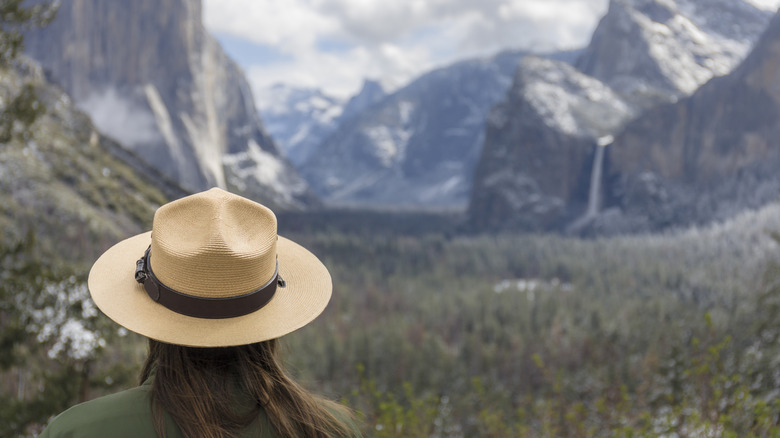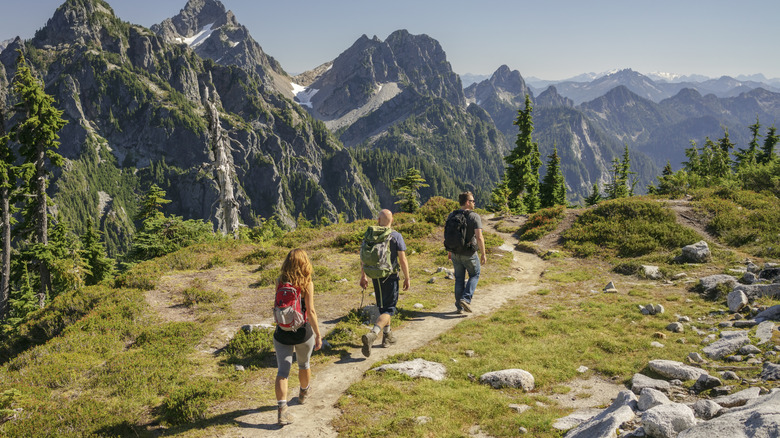What It Means To Be A 'Touron' And Why Park Rangers Can't Stand Those Types Of Visitors
We may receive a commission on purchases made from links.
Spend enough time in a national park and at some point, you might just hear the word "touron" muttered under someone's breath. This not-so-gentle portmanteau of "tourist" and "moron" is a nickname given to travelers who tend to treat wild places like theme parks, putting themselves — and the wildlife — at risk with their actions. While officials and park rangers are professionals and may not use the term, it's gained popularity with viral posts online. As the subreddit r/tourons explains, they are "tourists acting extremely irresponsibly in our national parks, sacred spaces, and vacation destinations."
They're the ones who get too close to bison for selfies in Yellowstone, who ignore safety barriers at the Grand Canyon, or who carve their names into ancient rock formations (seriously, why?). They don't always have bad intentions — sometimes it seems to be sheer ignorance. But these actions can have serious consequences. Every year, the National Park Service responds to hundreds of injuries, wildlife encounters, and damaged landmarks, many caused by visitors who either didn't read the signs or just chose to ignore them.
As the popular Instagram account @touronsofyellowstone reveals, rangers have seen it all: People approaching bears, trying to pet elk, or going off path near volatile geothermal features. The problem isn't just that they're breaking the rules — it's that one touron moment can result in tragic accidents, or harm ecosystems that can take centuries to recover. So to avoid doing anything "touronic," always stay aware of your surroundings and follow the park's rules and guidance. Remember: You're a guest in a wild space that doesn't exist for your entertainment.
Don't be a touron: Why respectful tourism matters
Being a respectful tourist starts with knowing where you are and what's at stake. No matter which beautiful places in state and national parks you're visiting, it's essential to focus on safety first and foremost. For example, many of the most common touron behaviors come from underestimating wild animals. Bison may look docile, but they can charge up to 35 mph with little warning. Approaching one for a selfie can easily land you in the hospital or worse. And it's not just large animals or predators you should leave be. Rangers wish tourists would treat all wildlife like the dangerous animals they are — even seemingly harmless mule deer, which have injured many visitors over the years.
Tourons also tend to ignore Leave No Trace principles — and that goes beyond littering. From walking off the designated trail in delicate ecosystems to stacking rocks in rivers for a trendy Instagram shot, these actions disrupt nature. Rangers spend countless hours repairing these small but damaging choices, often with limited staff and tight budgets.
To avoid being labeled a touron, it helps to research your destination ahead of time. Check for seasonal alerts (like fire bans), follow the marked trails, take out what you carry in, and give animals plenty of space. The absolute minimum distance you should keep is 25 yards, according to the National Park Service, with a recommended 100 yards from predators. If you really want a closer look, bring binoculars with you — these Occer compact binoculars are a popular choice. Ultimately, the term touron exists because there's a better way to experience nature. National parks are awe-inspiring not because they're Instagrammable, but because they've been protected and preserved for generations. Being a good guest helps make sure they'll still be there for the next one.

